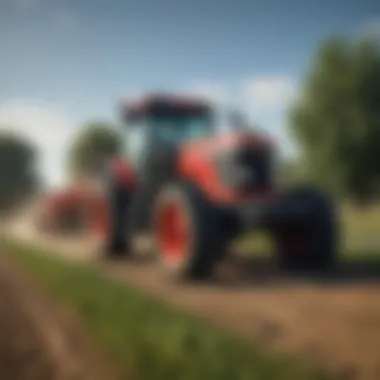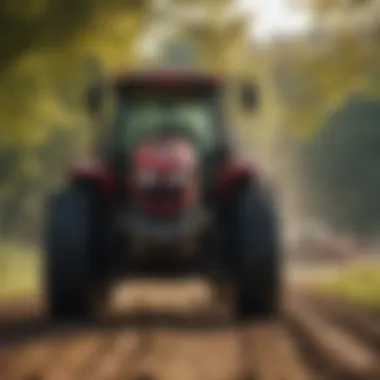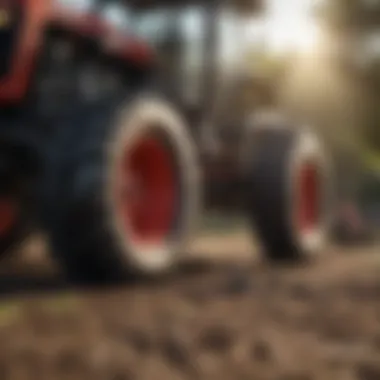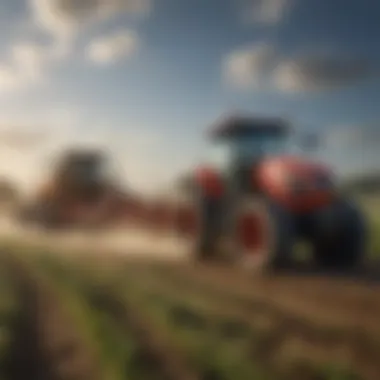St. Joe Equipment: Enhancing Agricultural Efficiency


Intro
St. Joe Equipment serves as a pivotal player in the realm of modern agriculture. Its significance extends beyond mere manufacturing; it embodies a commitment to enhancing farming efficiency through innovative machinery. Combining traditional practices with modern technology aids farmers in navigating the complexities of today's agricultural landscape. The following sections will unravel this interplay, providing insights into the relevance of St. Joe Equipment in sustainable farming and its innovations.
Topic Overview
Definition and Importance
St. Joe Equipment is more than just a supplier of tractors and implements. It aims to facilitate sustainable agricultural practices. This focus on sustainability is crucial in a world facing increasing environmental challenges. Farmers today find themselves under pressure to maximize production while minimizing ecological impact. St. Joe Equipment addresses these needs, offering tools that promote efficiency and sustainability.
Brief History and Evolution
Established several decades ago, St. Joe Equipment has evolved alongside the agricultural sector. Initially, it focused on basic farming machinery. However, as agricultural demands grew, so did the company's product range. The incorporation of advanced technology and sustainable practices reflects a broader trend in agriculture. This evolution makes St. Joe Equipment a key player in driving modern farming methods.
Key Techniques and Innovations
Sustainable Farming Practices
St. Joe Equipment emphasizes the integration of sustainable practices into farming operations. This includes the use of precision agriculture techniques, which optimize resource usage. These innovations help in reduction of waste, improving soil health, and enhancing crop yields. Some equipment is specifically designed to minimize soil compaction and promote crop rotation, key elements in sustainable farming.
Advanced Agronomic Technologies
Through its cutting-edge technology, St. Joe Equipment offers tools ranging from sophisticated tractors to intelligent sensor systems. These advancements enable farmers to make informed decisions, improving operational efficiency. The use of data analytics provides insights into crop performance and resource management, allowing for adjustments that can significantly impact yield.
Practical Applications
Step-by-Step Guides
Implementing St. Joe Equipment's offerings can seem daunting at first. However, with a structured approach, farmers can seamlessly integrate these tools into their practices. Here’s a brief guide:
- Evaluate Your Needs: Assess the specific requirements of your farm.
- Research Equipment: Understand the features of various St. Joe Equipment products that align with your needs.
- Training: Participate in training sessions offered by the company to maximize the effectiveness of the equipment.
- Gradual Integration: Start with one type of equipment before expanding your inventory.
- Monitor and Adjust: Continuously evaluate performance and adapt usage based on results.
Case Studies or Real-World Examples
One noteworthy example involves a mid-sized farm that integrated St. Joe Equipment’s precision farming tools. After employing these technologies, the farm reported a remarkable increase in efficiency. They achieved a 20% reduction in water usage while crop yields improved by 30%. Such examples illustrate the tangible benefits of utilizing modern equipment in agriculture.
"Adopting modern farming techniques not only improves productivity but also contributes to sustainable practices that benefit the environment."
Preamble to St. Joe Equipment
Understanding St. Joe Equipment is critical for comprehending the landscape of agricultural machinery. This company plays a significant role in the agricultural sector, supplying essential equipment that farmers rely on for various operations. With the increasing demands of modern farming, knowing what St. Joe Equipment offers becomes indispensable. It not only provides essential tools for farming but also contributes to the broader implications of sustainable farming practices.
Historical Background
St. Joe Equipment has grown from humble beginnings into a key player in the agricultural equipment industry. Established in the early 2000s, the company started with a small range of tractors and implements. Over the years, it expanded its product line to include more sophisticated machinery adapted to modern agriculture. The company’s origin story reflects a commitment to supporting local farmers, leveraging technology to improve efficiency in farming practices. Today, St. Joe Equipment has established a reputation for reliability and quality.
Business Philosophy
St. Joe Equipment operates under a business philosophy that emphasizes sustainability and innovation. The company believes in providing equipment that helps farmers not just to maximize productivity but also to minimize environmental impacts. This philosophical approach influences their designs, turning towards energy-efficient solutions that align with global sustainability goals. Additionally, they maintain close relationships with their customers, allowing feedback to shape future innovations and enhancements in their equipment offerings.
"Our goal is to empower farmers with tools that enhance their practices while being mindful of our planet's health." - St. Joe Equipment Executive
Overview of Equipment Types
Understanding the types of equipment offered by St. Joe Equipment is essential for anyone involved in modern agriculture. Each type serves a unique purpose, enhancing productivity, efficiency, and the overall farming experience. This section elaborates on various categories of equipment, providing insights into their functions and advantages.
Tractors


Tractors form the backbone of agricultural machinery, providing power and versatility for a wide range of tasks.
Types of Tractors
Tractors come in several types that cater to specific farming needs. The main categories include utility tractors, row crop tractors, and specialty tractors. Utility tractors are designed for general tasks such as plowing, while row crop tractors are built to operate in narrow rows for crops like corn and soybeans. Specialty tractors, on the other hand, serve niche markets, such as orchard or vineyard work. The selection of tractor type is vital for optimizing operational efficiency. Each type has unique features, like horsepower variations and design elements, which influence their performance.
Performance Metrics
Performance metrics for tractors include horsepower, fuel efficiency, and torque. These metrics are crucial as they determine how effectively a tractor can perform tasks. For example, tractors with higher horsepower can handle larger implements and heavier loads. Fuel efficiency measures how much fuel the tractor consumes relative to the work done. When evaluating tractors, it is important to consider these metrics to ensure proper matching with farm needs, which can have a direct impact on operational costs.
Customer Feedback
Customer feedback reveals critical insights into the usability and reliability of tractors. Reviews often highlight features such as ease of operation, comfort, and serviceability. Positive feedback on customer service and spare parts availability also plays a significant role in brand loyalty. By understanding customer experiences, potential buyers can make informed decisions about which tractors will best fit their needs.
Tillage Equipment
Tillage equipment is essential in preparing the soil for crop planting. It not only impacts crop yield but also influences soil health.
Types of Tillage Implements
Various tillage implements include plows, harrows, and cultivators. Each type is designed for specific tillage practices. For example, moldboard plows turn over the top layer of soil, creating a conducive environment for planting. Harrows provide finer soil preparation, while cultivators are great for weed control. The right choice in tillage implements can significantly affect seedbed conditions and crop establishment.
Sustainability Considerations
Sustainability in tillage practices focuses on reducing soil erosion and preserving soil health. Conservation tillage, which reduces the amount of soil disturbed, is gaining attention. This method can improve water retention and organic matter in the soil. Implementing sustainable practices can be an advantage for farmers aiming for long-term productivity without compromising environmental health.
Planting Machinery
Planting machinery plays a vital role in accurate seed placement, which is essential for crop growth.
Seed Planters
Seed planters come in various designs, including mechanical and precision planters. Mechanical planters are suitable for broad-acre crops, while precision planters offer accurate seed placement for smaller plots. The choice often depends on crop type and farming method. Each type has its own advantages and can drastically affect crop yields.
Fertilization Equipment
Fertilization equipment is specifically designed to apply fertilizers efficiently. Options include spreaders and injectors. Spreaders disperse granular fertilizers over a wider area, while injectors place liquid fertilizers directly into the soil. Proper fertilization is crucial for maximizing crop growth, and choosing the right equipment can lead to better nutrient management.
Harvesting Equipment
Harvesting equipment is critical during the harvest season, ensuring crops are gathered efficiently and with minimal loss.
Combines
Combines are one of the most sophisticated pieces of harvesting equipment. They harvest grain crops, cutting and processing them in a single operation. Combining tasks such as cutting, threshing, and winnowing, they enhance efficiency compared to traditional methods. Selecting the right combine can optimize harvesting times, directly influencing a farmer's bottom line.
Specialty Harvesters
Specialty harvesters cater to specific crops, such as fruits, vegetables, and nuts. Due to the delicate nature of these crops, specialty harvesters are designed to minimize damage during harvest. Their technology is often specialized, with features such as adjustable height or gentle handling mechanisms. This level of specialization means farmers can efficiently gather their crops while maintaining quality.
Technological Innovations
Technological innovations play a critical role in shaping the future of agriculture. In this section, we examine how advancements like smart farming and sustainable equipment design are not just trends but are essential for improving efficiency and minimizing environmental impact. Embracing these innovations can offer numerous benefits, including increased productivity, better resource management, and reduced costs, which are vital in today's competitive agricultural landscape.
Smart Farming Integration
GPS Technology
GPS technology has revolutionized farming practices by enabling precision agriculture. This technology allows farmers to monitor and manage their land with unmatched accuracy. One of the key characteristics of GPS in farming is its ability to provide real-time data on field conditions. For St. Joe Equipment, this enhances the decision-making process related to planting, fertilization, and harvesting.


The unique feature of GPS technology is its ability to create detailed maps that display variations in soil quality and crop health. These maps help farmers apply resources more efficiently, ensuring they are directed where they are most needed. However, there are some disadvantages. For instance, the reliance on GPS can pose complications if signals are weak or interrupted in remote locations.
Data Analytics in Equipment
Data analytics has emerged as a fundamental tool in agricultural management. It involves collecting and analyzing data to gain insights into farming operations. A key characteristic of data analytics is its ability to integrate with various sensors and machinery. In the context of St. Joe Equipment, this technology supports better decision-making by providing actionable insights into crop yields and machinery performance.
The unique feature of data analytics in agriculture is its capability to forecast trends and improve operational efficiency. Nonetheless, there are challenges too. Implementing data analytics can require significant investment in technology and staff training, which may deter smaller operations from adopting these advancements.
Sustainability in Equipment Design
Energy Efficiency
Energy efficiency is becoming a primary consideration in the design of agricultural equipment. The impact of energy consumption on operational costs has prompted manufacturers to innovate. The key characteristic of energy-efficient machinery is its ability to deliver high performance while consuming less energy, which is critical for sustainable agriculture.
A unique feature of energy-efficient designs is the incorporation of alternative fuels and electric power systems. While these developments offer potential cost savings and reduced emissions, the disadvantages can include higher initial costs and the need for infrastructure development to support charging or fueling these systems.
Emissions Standards Compliance
Emissions standards compliance is increasingly important in today's market. Equipment that meets established environmental regulations demonstrates a commitment to sustainable practices. One critical characteristic of this compliance is the integration of advanced engine technologies that reduce harmful emissions. For St. Joe Equipment, adhering to these standards reflects their dedication to environmental responsibility.
The unique feature of emissions compliant equipment is its ability to operate efficiently while minimizing ecological impact. However, compliance may require ongoing modifications and updates to machinery, presenting a potential disadvantage in terms of costs and operational complexity.
In summary, embracing technological innovations is not just about staying competitive. It is about cultivating a sustainable future for agriculture.
Market Position
The market position of St. Joe Equipment plays a crucial role in understanding its contributions to modern agriculture. Analyzing this aspect provides insights into where the company stands among its competitors, its share in the agricultural machinery market, and its ability to attract and retain a customer base. Essentially, a strong market position can indicate the effectiveness of St. Joe Equipment's products and its strategy in addressing consumer needs.
Competitive Landscape
Key Competitors
St. Joe Equipment faces competition from established brands such as John Deere, Case IH, and AGCO. Understanding these competitors is essential because it shows how they influence market dynamics and customer preferences. Each of these brands has a stronghold in specific segments, and their reputation for quality and innovation makes them formidable. For instance, John Deere is well-known for its advanced technology integrated into equipment, which is appealing for customers seeking precision farming solutions. This competitive characteristic helps maintain their position as a popular choice in the market. However, there can be disadvantages, such as higher price points that some potential customers may find prohibitive.
Market Share Analysis
The analysis of market share reveals how St. Joe Equipment compares against others in the industry. Market share is a key performance indicator that reflects the company's sales volume relative to the overall industry. St. Joe Equipment's share may highlight its growth potential or indicate possible challenges. A significant aspect of this analysis is understanding which segments are growing, such as sustainable farming practices, where St. Joe Equipment might capitalize on emerging trends. This characteristic is beneficial as it signifies opportunities for expansion, but relatively smaller market share compared to leaders may pose challenges in brand visibility.
Customer Base
Target Demographics
The target demographics of St. Joe Equipment encompass a variety of agricultural producers, from small family farms to larger commercial operations. Understanding these demographics is beneficial as it helps the company tailor its products and marketing strategies to meet specific needs. For example, smaller farms may prefer compact, multi-functional machinery that is economical. This tailored approach can create loyalty among customers who find their operational demands met effectively. However, focusing heavily on one demographic might alienate others, which is a risk that must be managed carefully.
Geographic Reach
St. Joe Equipment's geographic reach is substantial, spanning several regions where agricultural activity is prominent. Its operation in diverse areas allows it to tap into different market segments and adapt products based on regional agricultural practices. A broad reach is advantageous as it reduces dependency on a single market, providing resilience against local economic shifts. Yet, challenges may arise from managing different customer expectations and operational logistics across these varied regions.
"A company’s market position not only reflects its current standing but also shapes its future growth strategies."
In summary, the market position of St. Joe Equipment is multifaceted, containing layers of competitive insights, customer analysis, and geographical strategy. Each aspect reveals opportunities and obstacles, providing a rich context for understanding the company’s role in the agricultural machinery industry.
Importance of St. Joe Equipment in Sustainable Agriculture
St. Joe Equipment plays a critical role in promoting sustainable agriculture. This encompasses various factors, including efficient resource utilization and minimizing environmental impacts. Each piece of equipment offered by St. Joe is designed with sustainability in mind, emphasizing the need for farmers to adopt practices that will not only enhance productivity but also protect the environment.
Efficient Resource Utilization
One of the key benefits of St. Joe Equipment is its emphasis on efficient resource utilization. Farmers often face challenges in optimizing their inputs. This is where precision agriculture comes into play. St. Joe Equipment provides tools that enhance the effectiveness of resources like water, fertilizers, and seeds. For example, tractors equipped with advanced GPS technology allow farmers to apply inputs in a targeted manner. This reduces waste and ensures that every drop counts.


Furthermore, the design of tillage equipment fosters better soil health. By minimizing soil disturbance, it promotes organic matter retention and leads to a more balanced ecosystem. When resources are used efficiently, it not only positively affects yields but also reduces costs over time. Efficient use of resources aligns with the movement towards sustainable farming. It reflects a commitment to stewardship of the land, demonstrating that profitability need not come at the expense of environmental health.
Minimizing Environmental Impact
Minimizing environmental impact is another critical aspect of St. Joe Equipment's approach to sustainable agriculture. The equipment offered is designed to adhere to strict emissions standards. This is increasingly important as regulations surrounding emissions become more stringent. Farmers who invest in St. Joe's machinery can operate more responsibly, contributing to broader sustainability goals.
Reducing soil erosion is equally vital. The implements designed for planting and harvesting are meant to maintain soil integrity. By using cover crops and conservation tillage, farmers can significantly reduce erosion rates. This helps preserve the topsoil, which is crucial for growing nutritious crops.
"Adopting sustainable practices can lead to improved environmental outcomes and increased profits in the long run."
St. Joe Equipment also actively encourages the adoption of new technologies, which can further lessen environmental footprints. With ongoing innovations in agricultural machinery, there is a push for equipment that optimizes fuel usage and reduces harmful emissions.
In summary, St. Joe Equipment stands out not just for its range of high-quality products but also for its commitment to sustainability. By focusing on efficient resource utilization and minimizing the environmental impact, it supports farmers on their journey to more sustainable practices.
Future Trends and Challenges
The agricultural industry faces several ongoing trends and challenges that influence not only equipment manufacturers like St. Joe Equipment but also farmers and stakeholders in the sector. Understanding these trends is crucial. As technology advances, farmers seek tools that enhance productivity and sustainability. The pressure to adopt efficient practices is growing, driven by both market demands and environmental concerns.
Emerging Technologies
Automation Advances
Automation in agriculture represents a significant shift toward improving efficiency and reducing labor costs. Automation advances include systems like autonomous tractors and automated planting machinery. These tools allow for consistent performance, minimizing human error and fatigue. With features like GPS navigation, automated machines can operate precisely and can work around the clock. This is especially beneficial in large-scale farming operations, helping to improve yields without increasing labor costs.
However, automation can also pose challenges. High initial investment costs deter some farmers from adopting these technologies. Furthermore, reliance on automatic systems raises questions about data security and machine malfunctions.
Robotic Applications
Robotic applications in agriculture are becoming more popular. They offer a range of benefits such as precision and efficiency. For example, robotic harvesters can reduce wastage by selecting only ripe produce, ensuring better quality and less spoilage. The precision of robots can also minimize the amount of chemicals used in fertilization and pest control.
Despite these advantages, there are challenges as well. The cost of advanced agricultural robots can be prohibitive for small-scale farmers. Also, training is necessary to operate these machines correctly.
Market Dynamics
Consumer Preferences
Consumer preferences play a vital role in shaping the agricultural market. Today, more individuals are demanding sustainable and organically produced food. This trend pushes farmers to adopt better practices and invest in equipment that aligns with eco-friendly farming. A shift towards transparency in sourcing is also noticeable. Farmers must adapt to meet these expectations to remain competitive in the market.
However, shifting consumer preferences can lead to uncertainty. Farmers need to stay informed about trends to avoid investing in products that might not be in demand later.
Regulatory Changes
Regulatory changes significantly impact agricultural practices and equipment used. Governments increasingly enforce stricter regulations regarding emissions and sustainable practices. These changes can compel farmers to update their equipment to comply with new standards, which could mean investing in more advanced technology. While these regulations aim to encourage eco-friendly farming practices, the initial compliance can be a financial burden.
St. Joe Equipment, keeping abreast of such changes, can offer solutions that comply with regulations while meeting users’ needs efficiently.
"Understanding future trends and challenges will help in making informed decisions in agricultural practices, aligning with both market demands and sustainability goals."
Through a thorough understanding of these aspects, St. Joe Equipment can position itself as a valuable partner in agriculture, ensuring both farmers and the environment benefit from modern innovations.
Closure
In this article, we examined the integral role of St. Joe Equipment within the agricultural sector. The discussion highlighted the vast array of machinery and tools provided, with an emphasis on optimizing for sustainable practices. As farming becomes increasingly reliant on efficiency and technology, St. Joe Equipment stands out for its commitment to innovation and quality.
Summary of Key Points
- Diverse Range of Equipment: St. Joe Equipment offers a comprehensive selection of tractors, tillage tools, planting machinery, and harvesting equipment designed to meet the specific needs of farmers.
- Technological Integration: The embrace of smart farming technologies, such as GPS and data analytics, enhances equipment performance and assists farmers in making informed decisions.
- Sustainability Focus: Through energy-efficient designs and adherence to emissions standards, St. Joe Equipment plays a critical role in minimizing environmental impact.
- Market Position: Understanding the competitive landscape allows stakeholders to navigate their choices effectively while identifying customer demographics and geographic outreach.
- Future Outlook: Emerging technologies and evolving market dynamics present both challenges and opportunities for St. Joe Equipment and its customers.
Final Thoughts
The significance of St. Joe Equipment in the realm of agriculture cannot be overstated. As the field of agriculture continues to evolve, equipment manufacturers like St. Joe must adapt to the changing landscape. Farmers and stakeholders alike should recognize this adaptability, combining modern machinery with sustainable practices to ensure the longevity of farming. The insights provided in this overview can guide informed choices, keeping farmers at the forefront of agricultural advancements. By leveraging the capabilities of St. Joe Equipment, the agricultural sector can aim for both productivity and sustainability in a changing world.
"A commitment to innovation is vital for the future success of agriculture."
This conclusion encapsulates the essence of the topics covered, offering a forward-looking perspective for the audience.



